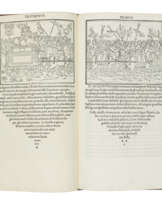ID 1349709
Lot 116 | [COLONNA, Francesco (1433-1527)]
Estimate value
£ 30 000 – 50 000
La Hypnerotomachia di Poliphilio. Venice: sons of Aldus Manutius, 1545
Second edition of the most influential illustrated printed book of the Italian renaissance, and widely considered one of the most beautiful. It tells the story of Polifilo's search for his lost love, Polia, and his journey through a fantastic dream-world of pyramids and obelisks, classical gardens, ruined temples and bacchanalian festivals, before finding her and gaining ultimate enlightenment at the temple of Venus. It has been highly influential both in text and image, even as recently as in Caldwell and Thomason's best-selling The Rule of Four, in which its hidden meanings feature. One of these is its hidden acrostic formed by the first initial in each chapter. When these letters are combined, they spell out: POLIAM FRATER FRANCISCVS COLVMNA PERAMAVIT, which translates as: ‘Brother Francesco Colonna has dearly loved Polia.’ This acrostic has been widely interpreted as revealing the true author of the work to be Francesco Colonna, a Dominican friar who lived from 1433 to 1527.
This second edition is essentially a reprint of the first, but without the woodcut initials and with a title-page in Italian rather than Latin. With only six exceptions the woodcuts are from the same blocks as the first edition; those blocks on b4v, b5r (2), e2v, e5r and x2r have been re-cut. Despite its claim to be 'corrected', the text on fos. n1v and n8r has been transposed, as it was in the first edition. Adams C-2414; Ahmanson-Murphy 335; Mortimer Harvard Italian 131; Renouard 133-34; Essling Pt. I, vol.2:2, no.119; Sander 2057.
Folio (291 x 195mm). 170 fine woodcuts, including 9 full-page, Dolphin and anchor printer's device on title, repeated on final verso, 5- to 9-line initial spaces with guide-letter, inscribed by the censor below the final device ‘Riveduto p[er] il p[ad]re Inquisitore’ (four leaves f6, m4, m5 and u8 supplied from another copy, m4-5 misbound after m6, small portion of the woodcut on K7 verso has failed to print, small hole in text of [*]4 and K4 with associated loss of a few letters, printing error affecting a couple of letters in first line of K2r, small stain in a few fore-margins). Modem green morocco gilt, panelled sides, spine gilt in compartments, gilt edges (extremities lightly rubbed, headcap slightly more heavily abraded). Provenance: ‘Lyon 1721 1 G’ (early inscription on flyleaf) – ‘J. Bridges’ (early inscription on flyleaf) – some faint lining in red to text and with early ink marginal annotation on y8-z1 – Evelyn Stainton (sold Sotheby’s 26 February 1931, lot 72) – Alan G. Thomas (1991-1992, bookseller; his private collection, sold, alongside 4 other editions of the Hypnerotomachia Poliphili, Sotheby’s 21 June 1993, lot 94) – purchased by the present consignor.
| Artist: | Francesco Colonna (1433 - 1527) |
|---|---|
| Place of origin: | Italy, Europe |
| Auction house category: | Books and manuscripts, Printed books |
| Artist: | Francesco Colonna (1433 - 1527) |
|---|---|
| Place of origin: | Italy, Europe |
| Auction house category: | Books and manuscripts, Printed books |
| Address of auction |
CHRISTIE'S 8 King Street, St. James's SW1Y 6QT London United Kingdom | |
|---|---|---|
| Preview |
| |
| Phone | +44 (0)20 7839 9060 | |
| Buyer Premium | see on Website | |
| Conditions of purchase | Conditions of purchase |
![[COLONNA, Francesco (1433-1527)] - photo 1 [COLONNA, Francesco (1433-1527)] - photo 1](/assets/image/picture_4361297/13845/0d80d521aaa1edb9fb185f8edb4cdddf1733871600jpg__fix_555_460.jpeg)
![[COLONNA, Francesco (1433-1527)] - photo 2 [COLONNA, Francesco (1433-1527)] - photo 2](/assets/image/picture_4361300/aac42/c850baf55f4f0c6f9e35fd9ceb72600d1733871600jpg__fix_555_460.jpeg)
![[COLONNA, Francesco (1433-1527)] - photo 3 [COLONNA, Francesco (1433-1527)] - photo 3](/assets/image/picture_4361303/7c71d/7c81bbbccfbb0781aceea2ba9422c5e31733871600jpg__fix_555_460.jpeg)
![[COLONNA, Francesco (1433-1527)] - photo 4 [COLONNA, Francesco (1433-1527)] - photo 4](/assets/image/picture_4361305/9b2ce/de47a472079c677b7111a94d74d4ef711733871600jpg__fix_555_460.jpeg)
![[COLONNA, Francesco (1433-1527)] - photo 5 [COLONNA, Francesco (1433-1527)] - photo 5](/assets/image/picture_4361307/1c1f8/22b20fa57bac16f0040bf1f863b373861733871600jpg__fix_555_460.jpeg)

![[COLONNA, Francesco (1433-1527)]](/assets/image/picture_4084655/33a94/mwnwn8cd-omr2qb0nxosypropyxwmkrqxji8yb1dvhowsw2h1axwtageyhnb4o1719907734jpg__fix_162_205.jpeg)

![[COLONNA, Francesco (1433-1527)]](/assets/image/picture_4734469/c2f49/55a6aac3568ad3ec763f9027816d09371752012000jpg__fix_162_205.jpeg)
![[COLONNA, Francesco (1433-1527)] - photo 1 [COLONNA, Francesco (1433-1527)] - photo 1](/cache/lot/1349709/0d80d521aaa1edb9fb185f8edb4cdddf_1733871600-80x80_center_50.jpg)
